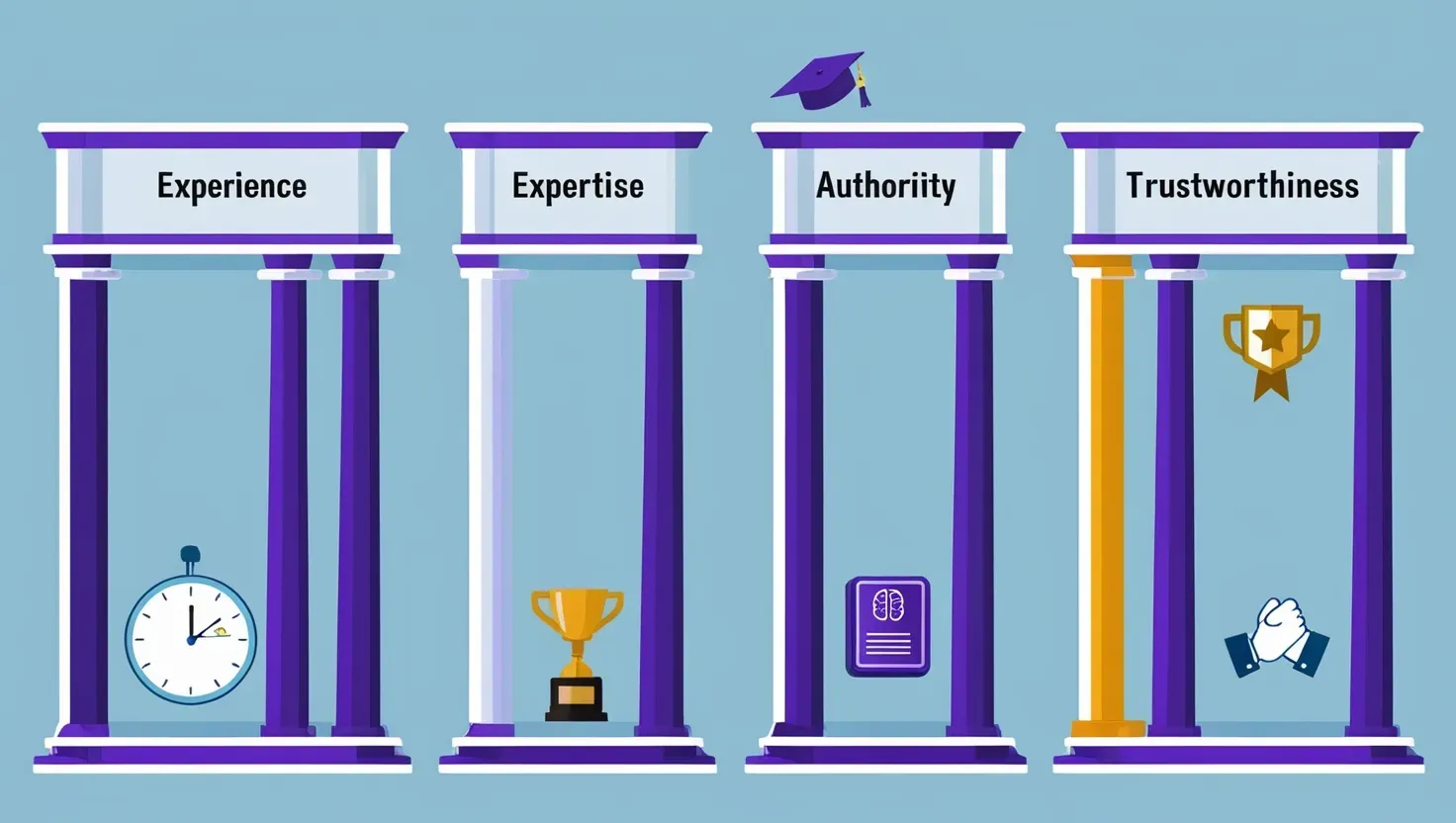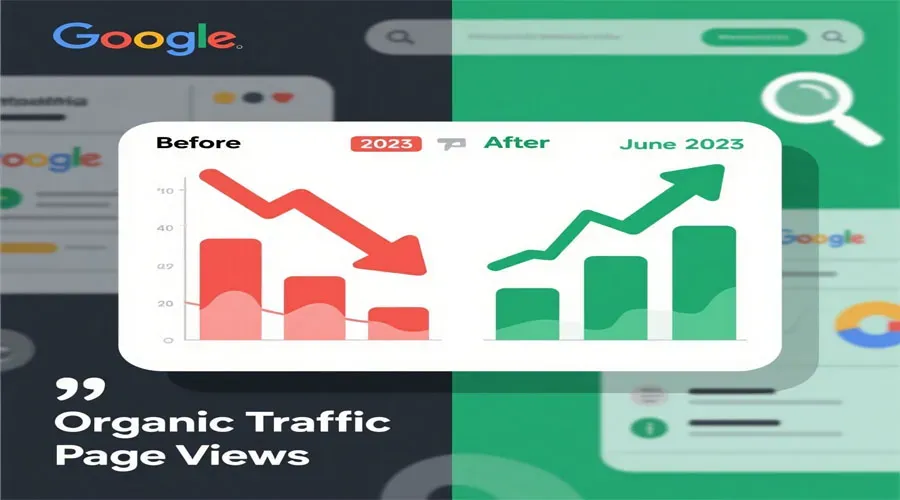The digital world is buzzing with excitement and fear about artificial intelligence. You’ve probably heard the whispers in SEO communities and maybe even felt the tremor in your website traffic. Google’s SEO Policies in 2025 have taken a dramatic turn that’s reshaping how we think about content creation forever.
Imagine waking up one morning to find your website has disappeared from Google’s first page. Your traffic has plummeted. Your business is struggling. This nightmare became reality for thousands of website owners when Google rolled out its game-changing updates throughout 2025. The search giant has fundamentally altered how it treats AI-generated content and images, creating winners and losers in the digital space.
But here’s the thing – this isn’t just about AI content being “bad” or “good.” It’s about understanding the new rules of the game and playing by them smartly. Google’s latest SEO Policies aren’t trying to eliminate AI content entirely. Instead, they’re demanding something more: authenticity, quality, and genuine value for real people.
In this guide, we’ll explore deep into exactly what these changes mean for your website, your content strategy, and your bottom line. You’ll discover the shocking truth about what Google is really looking for, learn the specific tactics that can save your rankings, and understand how to use AI tools without triggering penalties.
1. Understanding Google’s Revolutionary E-E-A-T Framework for AI Content
The Evolution Beyond Traditional E-A-T
Google’s E-E-A-T framework (Experience, Expertise, Authoritativeness, Trustworthiness) has become the cornerstone of modern SEO Policies in 2025. The addition of “Experience” wasn’t just another letter – it was Google’s way of fighting back against the flood of generic AI content that started overwhelming search results.
Think about it this way: anyone can ask ChatGPT to write an article about cooking pasta. But only someone who has actually burned the garlic, overcooked the noodles, and learned from countless kitchen disasters can provide genuine, helpful insights. Google’s algorithms have become incredibly sophisticated at detecting this difference.

The search engine now prioritizes content that demonstrates real-world experience and personal insights. This means your AI-generated content needs to be enhanced with genuine human experiences, personal anecdotes, and unique perspectives that only come from actually doing something, not just reading about it.
How Google Detects Authentic Experience
Google’s quality raters have been specifically trained to identify content that lacks genuine experience. They look for specific markers: detailed process descriptions, common mistake warnings, personal tips that aren’t found in standard guides, and conversational elements that show real understanding of user pain points.
This doesn’t mean AI content is automatically disqualified. Instead, it means AI content must be carefully crafted and enhanced with authentic human insights to meet Google’s new standards. The key is blending AI efficiency with human authenticity to create content that genuinely serves user needs.
2. The June 2025 Algorithm Earthquake: What Really Happened
The Massive Traffic Shifts
Google’s June 2025 core update sent shockwaves through the SEO community. Websites that had been ranking well for years suddenly found themselves buried on page 10. The update was specifically designed to target low-quality, scaled AI content that provided little value to users.
According to recent data, sites heavily relying on unedited AI content saw traffic drops of up to 70%. Meanwhile, websites that used AI as a starting point but added substantial human oversight, editing, and unique insights actually saw traffic increases. This created a clear divide between winners and losers in the new landscape of SEO Policies in 2025.
The update was particularly harsh on sites that displayed obvious patterns of AI generation: repetitive structures, generic conclusions, lack of specific examples, and content that felt like it was written by a machine rather than a person with real expertise.
The Quality Rater Guidelines Revolution
Perhaps even more significant than the algorithm changes were the updates to Google’s Quality Rater Guidelines. For the first time, quality raters were explicitly instructed to identify and negatively rate AI-generated content that failed to meet quality standards. This wasn’t about detecting AI usage – it was about detecting poor-quality content regardless of how it was created.
The new guidelines emphasize that content should demonstrate “first-hand experience” and provide “substantial value” beyond what could be found elsewhere. This means simply rephrasing existing information, even if done well by AI, is no longer sufficient for high rankings under the current SEO Policies in 2025.
3. AI-Generated Images: The Hidden SEO Landmine
Google’s Surprising Stance on Visual Content
While much attention has focused on text content, AI-generated images have created their own set of challenges and opportunities in Google’s current SEO Policies in 2025. Surprisingly, Google has stated that AI-generated images don’t automatically hurt SEO rankings, but there are crucial caveats that most people miss.
The key issue isn’t whether images are AI-generated, but whether they serve users effectively and provide genuine value. Generic stock-photo-style AI images that add no real context or information can actually hurt your SEO performance by creating a poor user experience.
However, custom AI images that specifically illustrate concepts, provide unique visual explanations, or enhance understanding of content can actually boost SEO performance. The difference lies in intentionality and user value, not in the generation method itself.
The Metadata Revolution
One of the most overlooked aspects of using AI-generated images is proper metadata implementation. Google’s SEO Policies in 2025 now require transparent labeling of AI-generated visual content in specific contexts, particularly for e-commerce and health-related websites.
This includes implementing IPTC metadata standards and providing clear alt text that describes not just what the image shows, but how it relates to the content and user needs. Images without proper context and metadata are increasingly being devalued in Google’s ranking algorithms, regardless of their visual quality.
4. The Death of Scaled Content Abuse
Understanding Google’s New Definition
Google’s crackdown on “scaled content abuse” has redefined what constitutes spam in the age of AI. It’s no longer just about keyword stuffing or link farms – it’s about creating large volumes of content without adding substantial value for users.
Under the new SEO Policies in 2025, even well-written AI content can be classified as spam if it’s produced at scale without sufficient human oversight and unique value addition. This has caught many content marketers off guard who thought that grammatically correct, readable AI content would be sufficient.
The policy specifically targets websites that use AI to rapidly produce hundreds or thousands of pages targeting long-tail keywords without providing genuinely helpful information that users couldn’t find elsewhere. Google’s algorithms have become remarkably sophisticated at detecting these patterns, even when the individual pieces of content appear high-quality.
The Quality Over Quantity Paradigm
The message from Google is clear: quality trumps quantity in every scenario. A single, exceptionally well-researched and uniquely valuable piece of content will outrank dozens of generic AI-generated articles targeting similar keywords.

This shift has forced a complete rethinking of content strategies. Instead of producing 50 AI-generated blog posts per month, successful websites are now focusing on creating 5-10 pieces of exceptional content that genuinely serve user needs and demonstrate real expertise and experience.
5. Building AI-Resistant Content Strategies
The Human-AI Collaboration Model
The most successful content creators in 2025 have learned to use AI as a research assistant and first-draft generator, not as a final content creator. This approach allows them to benefit from AI’s efficiency while ensuring the final product meets Google’s standards for authenticity and value.
The process typically involves using AI for initial research, outline creation, and draft generation, followed by substantial human editing that adds personal insights, specific examples, updated information, and unique perspectives. This hybrid approach satisfies Google’s SEO Policies while maintaining content production efficiency.
The key is ensuring that the human contribution is substantial and meaningful, not just cosmetic editing. Google’s algorithms can detect when content has been meaningfully enhanced by human expertise versus when it’s just been lightly edited for grammar and style.
Creating Undetectable Value
The most effective AI-resistant content focuses on providing value that genuinely can’t be replicated by machines alone. This includes personal case studies, real-world testing results, interviews with industry experts, and analysis of current trends that require human judgment and experience.
Content creators who thrive under the new SEO Policies consistently ask themselves: “What unique value am I adding that a user couldn’t get from asking an AI directly?” This mindset shift has proven crucial for maintaining rankings in the current environment.

6. Technical Implementation of AI Content Guidelines
Structured Data and Transparency Signals
Google’s SEO Policies in 2025 increasingly reward websites that are transparent about their content creation processes. This includes implementing structured data that indicates when content has been human-reviewed, when it includes original research, and when it provides unique insights.
Smart website owners are now including author bylines with detailed credentials, publication dates that show content freshness, and clear indicators of content verification processes. These transparency signals help Google’s algorithms understand that content has undergone proper quality control, regardless of whether AI was used in the creation process.
The technical implementation also includes proper use of schema markup for articles, ensuring that Google understands the context and authority behind content. This has become particularly important for YMYL (Your Money or Your Life) topics where content quality directly impacts user safety and well-being.
Page Speed and User Experience Integration
An often-overlooked aspect of Google’s current SEO Policies is how content quality interacts with technical SEO factors. AI-generated content that loads quickly and provides excellent user experience signals will generally outrank human-written content that creates poor user experiences.
This means that the technical implementation of content is just as important as the content itself. Websites that combine high-quality, human-enhanced AI content with excellent technical performance are seeing the best results in current search rankings.
7. Future-Proofing Your Content Strategy
Preparing for Continued Evolution
Google’s SEO Policies in 2025 are not the end of the story – they’re just the beginning of a fundamental shift in how search engines evaluate content. The trend toward prioritizing authentic experience and genuine value is likely to continue and intensify as AI content becomes more prevalent.
Smart content creators are already preparing for the next phase of evolution by building systems that prioritize human expertise and real-world testing. This includes developing relationships with industry experts, creating original research processes, and building content workflows that ensure every piece provides genuine value.
The key is building sustainable processes that don’t rely on gaming the system but instead focus on genuinely serving user needs better than competitors. This approach provides protection against future algorithm changes while building genuine business value.
Building Long-Term Authority
The websites that will thrive in the future are those that use this transition period to build genuine authority and expertise in their niches. This means investing in real expertise, conducting original research, and building reputations based on genuine value rather than SEO manipulation.
Under Google’s evolving SEO Policies and beyond, the websites that demonstrate consistent expertise, regular content updates, and genuine engagement with their audience will continue to rank well regardless of how the technical details of algorithms change.
8. Case Studies: Winners and Losers in the AI Content Wars
The Success Stories
Several websites have not only survived but thrived under Google’s new SEO Policies. These success stories share common characteristics: they use AI as a tool for efficiency while maintaining high standards for human oversight and value addition.
One notable example is a technology review site that uses AI to help research technical specifications and generate initial drafts, but then has actual experts test products, add personal insights, and provide real-world usage scenarios. Their traffic increased by 40% after the June 2025 update because their content demonstrated genuine expertise and experience.
Another success story involves a health and wellness blog that uses AI for research and outline generation but ensures every article is reviewed by licensed healthcare professionals and includes specific, actionable advice based on real patient experiences. This approach has helped them maintain top rankings even in the highly competitive health niche.

The Cautionary Tales
On the flip side, numerous websites have experienced dramatic traffic losses by failing to adapt to the new reality. A common pattern among failing sites was over-reliance on AI-generated content without sufficient human enhancement or original value addition.
One particularly striking example was a travel blog that used AI to generate hundreds of destination guides without any first-hand travel experience.
9. Practical Implementation Guide
Step-by-Step Content Creation Process
Creating content that thrives under Google’s SEO Policies requires a systematic approach that balances efficiency with quality. The most successful creators follow a specific process that ensures every piece of content meets the new standards.
The process begins with thorough keyword research and user intent analysis, followed by AI-assisted research and outline generation. However, the crucial difference lies in the human enhancement phase, where experts add personal insights, real-world examples, and unique perspectives that transform generic AI output into valuable, authoritative content.
The final step involves rigorous quality control that checks not just for accuracy and readability, but for genuine value addition and user experience optimization. This comprehensive approach ensures content meets both user needs and Google’s increasingly sophisticated quality standards.
Quality Control Checklists
Successful websites operating under current Policies use detailed quality control checklists to ensure consistency and compliance. These checklists typically include verification of factual accuracy, assessment of unique value proposition, confirmation of expertise demonstration, and evaluation of user experience factors.
The most effective checklists also include specific checks for AI content enhancement: verification that human insights have been added, confirmation that examples are specific and relevant, and assessment that the content provides value beyond what users could obtain from AI chatbots directly.
10. Measuring Success in the New SEO Landscape
Key Performance Indicators
Traditional SEO metrics remain important, but the SEO Policies have introduced new factors that require different measurement approaches. Successful websites now track engagement metrics more closely, including time on page, return visitor rates, and social sharing patterns, as these provide signals of genuine user value.
Advanced analytics now focus on content quality indicators such as featured snippet capture rates, “People Also Ask” appearances, and organic click-through rates. These metrics provide better insights into whether content is truly serving user needs under the new quality standards.
Additionally, monitoring brand mention patterns and direct traffic growth has become crucial for understanding whether content is building genuine authority and trustworthiness – key factors in Google’s current ranking algorithms.
Long-Term Monitoring Strategies
The volatile nature of SEO Policies in 2025 requires more sophisticated monitoring approaches than traditional SEO tracking. Successful websites implement continuous monitoring systems that track not just rankings and traffic, but also content quality signals and user satisfaction metrics.
This includes regular content audits to identify underperforming pieces that may need human enhancement, competitive analysis to understand how other sites are adapting to the new requirements, and user feedback collection to ensure content genuinely meets needs and expectations.
Frequently Asked Questions
1. Will Google penalize my website if I use AI-generated content?
Google won’t automatically penalize AI-generated content, but the company has made it clear that all content must meet high quality standards regardless of how it’s created. Under the current SEO Policies in 2025, the key factors are whether your content provides genuine value, demonstrates expertise, and serves user needs effectively.
The risk comes from using AI to create scaled, low-quality content without sufficient human oversight. If you’re using AI as a starting point but adding substantial human insights, expertise, and unique value, you’re likely to perform well. However, if you’re publishing large volumes of AI content without meaningful human enhancement, you risk being classified under Google’s “scaled content abuse” policies.
The safest approach is to use AI as a research and drafting tool while ensuring that humans with genuine expertise review, enhance, and verify all content before publication. This approach allows you to benefit from AI efficiency while meeting Google’s quality standards for authenticity and user value.
2. How can I make my AI-generated content comply with Google’s E-E-A-T guidelines?
Making AI content compliant with Google’s E-E-A-T framework requires strategic human enhancement focused on adding genuine experience and expertise. Start by ensuring that people with real credentials and experience in your topic area review and enhance all AI-generated content.
Add personal anecdotes, specific examples from real experience, and insights that only come from actually working in the field. Include detailed author bios that establish credibility, cite authoritative sources, and provide unique perspectives that users couldn’t get elsewhere.
Under the SEO Policies, Google particularly values content that demonstrates first-hand experience. This means including specific details, common mistake warnings, and practical tips that show genuine understanding of user challenges. The goal is to transform generic AI output into content that clearly comes from someone who has real expertise and experience in the subject matter.
3. Are AI-generated images harmful to my SEO rankings?
According to Google’s official statements, AI-generated images don’t automatically harm SEO rankings. However, the context and implementation matter significantly under current SEO Policies in 2025. The key is whether the images genuinely serve users and enhance content understanding.
Generic, decorative AI images that add no real value can indirectly hurt SEO by creating poor user experiences. However, custom AI images that specifically illustrate concepts, provide unique visual explanations, or enhance content comprehension can actually boost SEO performance by improving user engagement and understanding.
For best results, ensure AI-generated images include proper metadata, relevant alt text, and clear connections to your content. For e-commerce and health-related sites, consider implementing transparency labels as recommended in Google’s guidelines. Focus on creating images that genuinely help users understand your content better rather than just decorating pages.
4. What’s the difference between acceptable AI content and scaled content abuse?
The distinction between acceptable AI content and scaled content abuse under Google’s SEO Policies primarily relates to value addition and human oversight. Acceptable AI content serves genuine user needs, provides unique insights, and demonstrates meaningful human enhancement and expertise.
Scaled content abuse involves creating large volumes of content without adding substantial value for users. This includes using AI to rapidly generate hundreds of pages targeting keywords without providing genuinely helpful information that users couldn’t find elsewhere.
The key factors Google considers include the uniqueness of insights provided, the depth of human expertise demonstrated, the genuine utility for users, and whether the content provides value beyond what users could get from AI chatbots directly. Content that passes these tests, regardless of AI involvement in creation, typically performs well in current search rankings.
5. How should I adapt my content strategy to comply with Google’s 2025 updates?
Adapting to Google’s SEO Policies in 2025 requires shifting from quantity-focused to quality-focused content strategies. Start by auditing your existing content to identify pieces that may need human enhancement or may be classified as low-value AI content.
Implement a hybrid approach where AI handles research, initial drafting, and outline generation, while humans with genuine expertise handle enhancement, fact-checking, and value addition. Focus on creating fewer pieces of exceptional content rather than large volumes of generic content.
Invest in building genuine expertise in your niche through original research, expert interviews, real-world testing, and personal experience documentation. Ensure all content clearly demonstrates the human expertise and experience that went into its creation. This approach not only complies with current policies but also builds long-term authority that will remain valuable as Google’s algorithms continue evolving.
Conclusion
The landscape of SEO Policies in 2025 has fundamentally changed how we approach content creation and digital marketing. Google’s sophisticated algorithms now demand authenticity, expertise, and genuine value in ways that were unimaginable just a few years ago. The message is clear: the era of gaming search engines with generic, scaled content is over.
However, this shift isn’t a death sentence for AI-powered content creation – it’s an evolution that rewards smart, strategic implementation. The websites thriving under these new policies have learned to harness AI’s efficiency while maintaining the human touch that provides genuine value to users. They understand that AI should enhance human expertise, not replace it.
The key to success lies in viewing AI as a powerful tool that amplifies human creativity and expertise rather than as a replacement for genuine knowledge and experience. Content creators who embrace this philosophy, focusing on providing authentic value while leveraging AI for efficiency, will continue to succeed regardless of how Google’s algorithms evolve. The future belongs to those who can blend artificial intelligence with authentic human insight to create content that genuinely serves user needs and builds lasting authority in their respective fields.
Key Takeaways
• Quality over quantity – Google’s 2025 algorithms prioritize exceptional content over scaled content production
• Human enhancement is crucial – AI-generated content must be substantially improved with genuine human expertise and insights
• E-E-A-T compliance is mandatory – Content must demonstrate Experience, Expertise, Authoritativeness, and Trustworthiness
• Transparency builds trust – Clear indication of content creation processes and author credentials improves rankings
• User value determines success – Content must provide genuine value that users couldn’t obtain from AI chatbots directly
• Technical implementation matters – Proper metadata, structured data, and user experience optimization are essential
• Continuous adaptation is required – SEO policies continue evolving, requiring ongoing strategy refinement and content improvement







